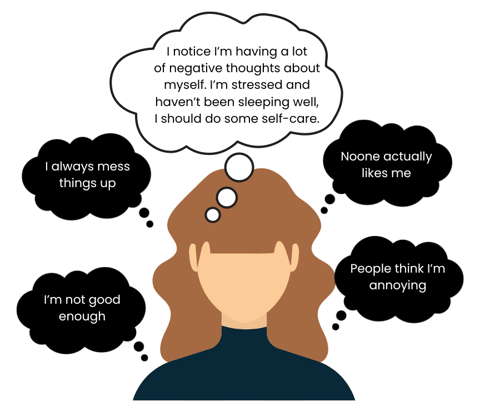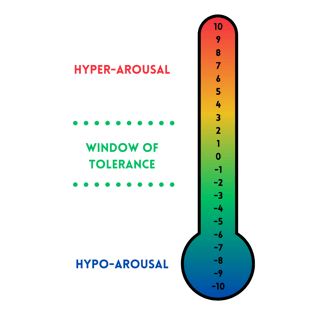3 Steps to Heal your Nervous System


To regulate and heal your nervous system, there are 3 key steps:
Step 1: Develop awareness of your internal state so you can gauge your current level of physiological arousal and emotional activation.
Step 2: Detach from strong thoughts and feelings that are tied to your current state.
Step 3: Apply strategies to bring yourself back into regulation.
Rinse and repeat! This is not a one-and-done process, the patterns of activation are well-conditioned by now and it takes persistence and repetition to re-wire neural circuits. Particularly in the face of strong emotional triggers it will take some time to affect lasting change, but it’s important to celebrate all the small marks of progress along the way.
So many of us live in our heads and are disconnected from our bodily sensations. For those with avoidant or disorganized attachment that are more prone to hypo-arousal, it might be hard to feel anything at all as you have been conditioned to shutting out this awareness, but keep at it, and keep noticing also the thoughts and emotions that come up.
There might be thoughts like “This is stupid!”, and you might come up with all sorts of reasons to not persist with the practice, but it could be that those thoughts come from the protective part of you that shut out those feelings in the first place and is trying to dissuade you from letting them back in!
We will talk more about these protective parts later, but for now just thank it and keep trying. Anything you notice is a success and with time and practice you will notice more.
Some people are hyper-aware of their bodily sensations and find it distressing to tune inwards, particularly for those who have PTSD/cPTSD or high levels of anxiety. If you do have a trauma-related disorder please practice this gently and ideally with support. The aim is push the edges of your window of tolerance to gradually expand it while staying within it, not to flood yourself into dysregulation.
The issue is that noticing physical signs of anxiety or distress can cause people to get anxious about their anxiety, fearful of escalating into a panic state, which only serves to compound it and make it worse.
The objective is to notice the things happening inside you and to maintain detached interest and curiosity, which includes noticing your thoughts without getting caught up in them.


Step 1: Developing Bodily Awareness
To develop an awareness of your internal processes and bodily sensations, check in with yourself regularly and spend a couple of minutes noticing what you notice.
To begin, you might want to set an alarm for a few times a day, this will get you into the habit of thinking about it, and any time you do think about it spend a little time just observing. There are so many ways you can do this, but perhaps the easiest way to start is to do a body scan from head to toe.
Notice your face, is there tension anywhere? If there is, is it dull or sharp?
Do your thoughts feel racey or spacey? Are you wired or tired?
Is there a colour or shape to how you’re feeling?
Scan down your body and keep noticing areas of tension, sensation, or numbness. Sit with each a little, try to describe it in colour or shape.
Notice your heart rate, your breathing. Don’t try to change anything, just let it be what it is. Does your breathing go all the way down to your diaphragm or is it all in your chest?
Notice your stomach, is there pain or discomfort? Is there a gnawing hollow feeling, a heaviness?
Continue with this all the way down to your feet. You can ask any parts of interest if there’s anything they are trying to tell you, often asking a question like this with a quiet and open mind can give some useful insight.
Practice this as often as you can and in a variety of different states. For starters, just engaging in this practice will help to calm you, and also this is how you can develop a rating scale to gauge your level of activation.
In trauma therapy we use the Subjective Units of Distress Scale (SUDS), which is a self-rated measurement on a scale that goes from 0-10, with 0 being perfectly calm, content and comfortable, and 10 being a full blown panic attack where you can't breathe and feel like you're going to die.
It’s important to note that 10 is the absolute max, the “ceiling to the feeling”. I personally like to also go into negative numbers to measure hypo-arousal, with -10 being completely dissociated and unaware of yourself or surroundings.


Step 2: Detach from strong thoughts and feelings
Over time you can build your own internal reference for how you are feeling and connect it to a number on the scale. The reason this number is so helpful is it gives you a more detached and objective way to describe how you are feeling, without using strong feeling-coded words that are likely to just amplify your state.
Instead of, “I’m feeling anxious, what have I done wrong that I need to feel bad about?” and then spiralling into thoughts that amplify the anxiety, it becomes “Hmm, I feel this tension in my jaw, a queasy feeling in my stomach, a feeling of guilt, and I'm starting to have a lot of negative thoughts about myself - I'm at a 6, I should take a few minutes to settle”.
This is really crucial, as mentioned in a previous post, your brain does not know the difference between a real and imagined threat, and it responds to strong thoughts and feelings as if they were actual external threats to your safety.
It’s quite an art to learn how to observe and allow space for your thoughts and feelings without getting caught up in them, and we will explore more techniques for this in another post.
One way I like to think of it is the difference between the sky and the weather. The sky is just the sky, it always is what it is. The weather changes constantly and even when it gets really stormy, the sky still just is. Sometimes the clouds are so heavy and dark that you can’t see the sky at all, but it is still there. Practice being the sky while noticing the weather, and if you feel yourself getting caught up in the storm, just be the sky again.


Step 3: Strategies to regulate
Once you have spent time noticing and observing, then you can start applying strategies to bring yourself back into regulation. I will go into more detail about different strategies, and it will be a process of finding out what works best for you, but whatever you do it’s important to do it properly. It’s no use trying some deep breathing while still allowing your thoughts to rampage about, you are likely to just say it doesn’t work and give up.
When you are making use of a regulating strategy, try to stay focused on the sensations you notice, your thoughts will pull and tug at you, thank them and keep at your process.
Be alert to micro-signs that the coping tool you are using is working. A little release of tension in your face, your shoulders soften, a yawn, your breathing slowing. When you notice these little shifts towards regulation, really slather on the praise and lean into it. This helps to release a little bit of dopamine that will enhance the work you are doing and will begin the work of reconditioning the nervous system to orient towards regulation.
Different states of arousal require different strategies. If you experience hypo-arousal, you will need to do things that raise your levels of physiological arousal; stand up, have a shake, pat down your body from top to toe, eat some sour or spicy food, listen to upbeat music, splash cold water on your face, use your voice to shout or sing - make use of all the different senses.
To settle hyper-arousal, you have the option to either calm and soothe or to work it out your system, depending on the situation and what works for you. To calm you can practice deep-breathing, progressive muscle relaxation, make use of sensory tools like soft and weighted blankets. To work it out your system you can punch pillows, do some intense exercise, play angry music and stomp it out. This helps to move the adrenaline through your body and gives an expressive outlet to feelings of anger.
It can be helpful to have something to do with your thoughts as well, to distract them from the spiral. Try looking at a painting and coming up with a story about it, or going through the alphabet thinking of country names that begin with each letter.
Distracting yourself with video games and movies is fine sometimes and definitely has its place and use, but be mindful to develop a range of other strategies that are more active and intentional as over the long term this is what is going to make the biggest difference to healing your nervous system.
Don't forget to praise yourself when you go through this process and you notice it helps, even a little! It might feel silly at first, but this part is important in reinforcing an internal sense of safety and calm.